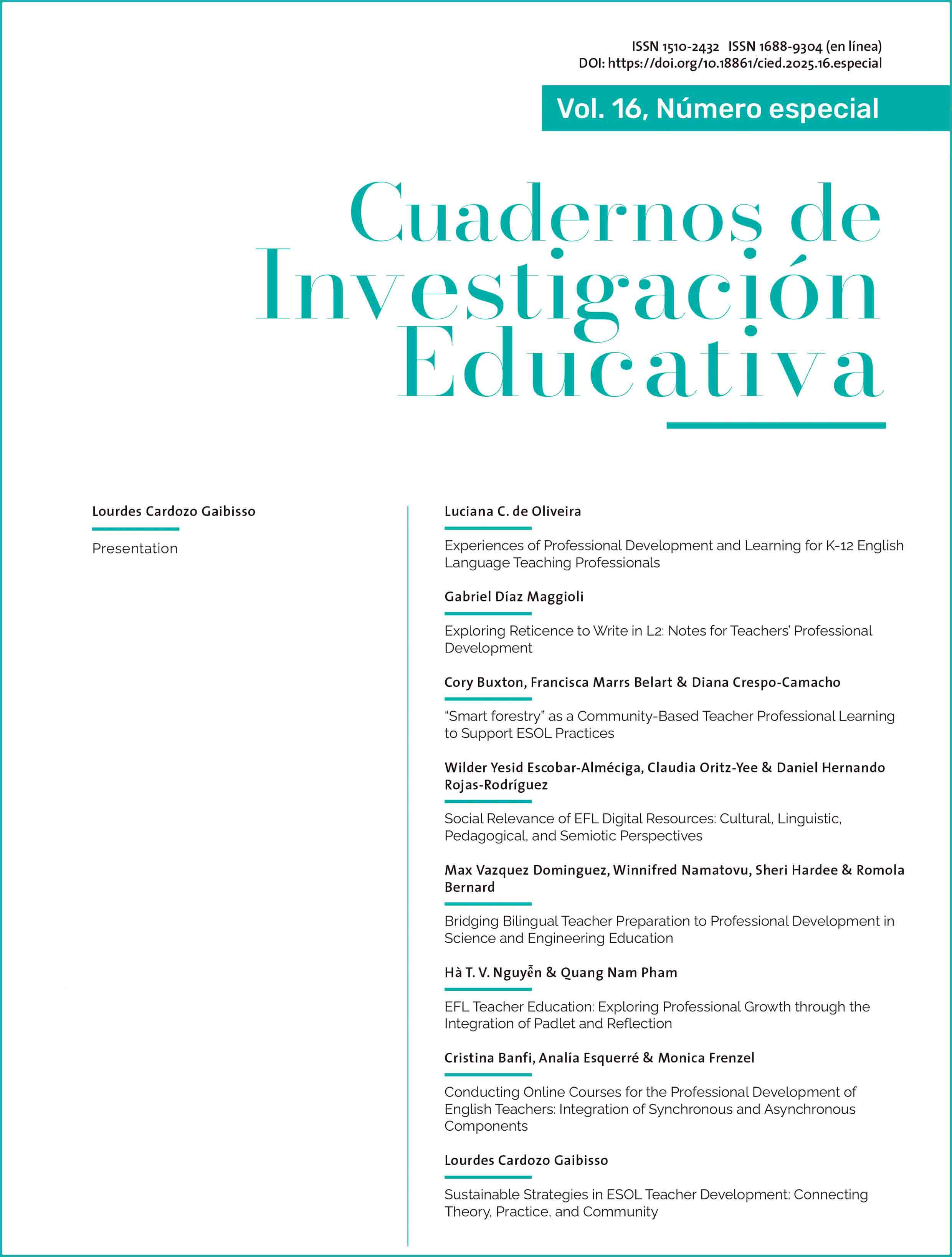Social Relevance of EFL Digital Resources: Cultural, Linguistic, Pedagogical, and Semiotic Perspectives
DOI:
https://doi.org/10.18861/cied.2025.16.especial.4066Keywords:
higher education, English as a Foreign Language, virtual learning, social semiotics, cultural sensitivityAbstract
This study examines the communicative affordances and limitations for culturally sensitive and linguistically relevant practices to the context and its population, inherent in the semiotic resources and communicative modes of an English as a Foreign Language (EFL) teaching digital platform used in an undergraduate program on Bilingualism and Bilingual Education at a private university in Colombia. Data were collected directly from the platform and analyzed through a multimodal lens, drawing on the frameworks proposed by Callow (2013) and Van Leeuwen (2005), from which a priori codes were identified and employed. Categorical themes of broader heuristic significance emerged from such coding processes, particularly concerning the intermodal relations present in the design and layout of the platform and their implications for student participation, collaboration, production, motivation, and inclusion. The findings revealed that analyzing instructional materials through a multimodal lens helps identify key areas for improvement, enhancing learner engagement and interaction in language learning. The integration of both verbal and visual elements in materials can enhance clarity, making content more accessible and reinforcing learning objectives when appropriately balanced. However, the LicBi platform reinforces cultural stereotypes and fails to promote intercultural awareness, limiting learners' ability to critically engage with diverse perspectives and develop essential skills like cultural sensitivity and global competence. The platform’s design prioritizes aesthetic symmetry over pedagogical interaction, creating a visual distance that reduces opportunities for meaningful communication and participation. Semiotic resources are underutilized, with visuals often serving decorative rather than instructional purposes, resulting in a lack of authentic, functional, and reflective language learning experiences.
Downloads
References
Botturi, L. (2003). Instructional design & learning technology standards. ICeF - Quaderni dell’Istituto, 9. https://doc.rero.ch/record/5154/files/1_icefq09.pdf
Callow, J. (2013). The shape of text to come. Primary English Teaching Association Australia (PETAA).
Christensen, H. D. (2016). ‘Plus de figures!’ On Saussure’s use of images. Visual Communication, 15(4), 487–507. https://doi.org/10.1177/1470357216645464
Escobar-Alméciga, W. Y. (2015). Language configurations of degree-related denotations in the spoken production of a group of Colombian EFL university students: A corpus-based study. Colombian Applied Linguistics Journal, 17(1), 114–129. https://doi.org/10.14483/udistrital.jour.calj.2015.1.a08
Escobar-Alméciga, W. Y. (2020). Ethnography of multimodal communication in an English-medium university-level classroom: A social semiotic perspective on learning [Doctoral dissertation, State University of New York at Buffalo].
Escobar-Alméciga, W. Y. (2022). Framing English as a medium of instruction within the Iberian-American Spanish-speaking education contexts. Profile: Issues in Teachers’ Professional Development, 24(1), 211–225. https://doi.org/10.15446/profile.v24n1.93434
Escobar-Alméciga, W. Y., & Brutt-Griffler, J. (2022). Multimodal communication in an early childhood bilingual education setting: A social semiotic interaction analysis. Íkala, Revista de Lenguaje y Cultura, 27(1), 84–104. https://doi.org/10.17533/udea.ikala.v27n1a05
Fairclough, N. (2003). Analysing discourse (Vol. 270). Routledge.
Fairclough, N. (2011). Semiotic aspects of social transformation and learning. In R. Rogers (Ed.), An introduction to critical discourse analysis in education (pp. 119–127). Routledge.
Gee, J. P. (2011). Discourse analysis: What makes it critical? In R. Rogers (Ed.), An introduction to critical discourse analysis in education (pp. 23–45). Routledge.
Kress, G. (2010). Multimodality: A social semiotic approach to contemporary communication. Routledge.
Kress, G. (2011). Discourse analysis and education: A multimodal social semiotic approach. In R. Rogers (Ed.), An introduction to critical discourse analysis in education (pp. 205–226). Routledge.
Paskaleva, B. (2024). Pre-structuralist semiology: Materiality of language in Ferdinand de Saussure. Semiotica, 2024(0). https://doi.org/10.1515/sem-2023-0114
Ragan, T. J., & Smith, P. L. (1999). Instructional design. Macmillan Publishing Company.
Rojas, D., & Escobar-Alméciga, W. Y. (2023). Student’s agency in English as foreign language learning in a virtual environment: An interaction analysis. Lengua y Sociedad, 22(2), 377–396. https://doi.org/10.15381/lengsoc.v22i2.25138
Tomlinson, B. (Ed.). (2023). Developing materials for language teaching (2nd ed.). Bloomsbury Publishing.
Unsworth, L. (2006). Towards a metalanguage for multiliteracies education: Describing the meaning-making resources of language-image interaction. English Teaching: Practice and Critique, 5(1), 55–76.
Van Leeuwen, T. (2005). Typographic meaning. Visual Communication, 4(2), 137–143. https://doi.org/10.1177/1470357205053740
Yassine, S. (2014). Multimodal design of EFL textbooks: A social semiotic multimodal approach. Anglisticum Journal of the Association-Institute for English Language and American Studies, 3(12), 84–90. https://doi.org/10.0001/(aj).v3i12.1523
Yi, X. (2024). From Saussure to Lacan: The primacy of the signifier. Lecture Notes in Education Psychology and Public Media. https://doi.org/10.54254/2753-7048/43/20240862






